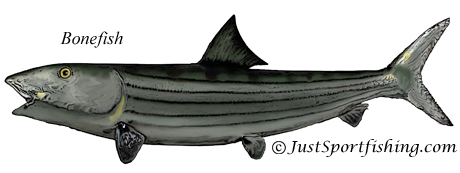|
|

How
to fish for Bonefish
Fishing for Bonefish can be done by boat or wading through the flats. Bonefish are predominately a coastal species, commonly found in inter-tidal flats, mangrove areas, river mouths, and deeper adjacent waters. Fishing for Bonefish is a very visual sport. When seeking Bonefish there are three main ways of spotting them.
The first and easiest Bonefish to spot is a tailing fish. Bonefish can often be seen with their tails sticking out of the water while feeding as they swim head down stirring up the bottom looking for prey. The second way to spot bonefish are mud clouds. On soft, sandy-bottomed flats, "blast holes" or small circular patterns left in the sand by feeding bonefish can be a sure sign that bonefish are present. Mud clouds are also definite indicators of feeding on the flats. When a Bonefish takes in a meal off the ocean floor, it makes a little cloud in the water from the sand. These mud clouds are where the Bonefish are feeding. The third way to spot a Bonefish, is to actually see the fish through the water. This method is easiest when the bottom of the flat is light colored sand. When scanning the flat you will look for any movement and dark spots in the sand.
To hook a Bonefish you need to make long and accurate casts. The Bonefish is easily spooked and will dart off if you approach to close. If you are fishing over a sandy bottom, which is usually the case, allow the fly to settle and then strip it off the bottom in little spurts. If the fish don't seem interested, try varying your retrieve until the fish respond. The most popular retrieve is a series of short, slow strips. Another productive technique is a fast strip followed by a dead stop. If the fish sees the fly, he will pick it up from a dead stop. The fish will usually pop its tail up as it takes the fly and the hook should be set immediately after this occurs; you will actually see many fish pickup the fly before you feel them. Many people miss fish because they don't set the hook in time - the fish has picked up the fly but hasn't been felt and drops it again.
When fly fishing for bonefish try flies like Crazy charlies, shrimp patterns, crab patterns, and minnow patterns in sizes #4, #6, or #8
A good size fly rod for bonefish is a stiff, fast action, 8 wt. This line size will effectively handle most conditions and have the power to punch out a line in a fairly stiff breeze. If you're planning to fish in an area that holds bonefish and permit, it would be wise to use a 9 wt rod that can handle the larger heavier permit flies. The new high modular graphite rods are the rage among saltwater anglers. With a very stiff butt section and ultra-fast tip speed, they enable the fisherman to punch heavy saltwater tapers into head wind. Fly rods that are 9 feet and over are recommended because they help keep lines up off the water while casting to and playing fish.
Use a weight forward, floating line with a saltwater taper in the weight appropriate for your rods. Generally a 9 ft leader with a couple of three ft 16 lb or 20 lb fluorocarbon tippet works well.

|
JustSportfishing.com

|


